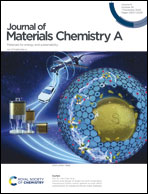Sugar-alcohol@ZIF nanocomposites display suppressed phase-change temperatures†
Abstract
For the sake of water and energy conservation, development of latent heat cooling and thermal storage systems that minimize water consumption and operate with higher efficacy than their water-driven counterparts is a crucial task. Phase change materials (PCMs) present a potential solution, but their integration into real-world systems abounds with scientific challenges such as material toxicity, flammability, low thermal performance and lack of tunable phase-change temperatures. In this study we report on a first-in-class nanocomposite PCM that leverages non-flammable, non-toxic, high latent heat sugar alcohols (SAs) encapsulated within easy-to-synthesize zeolitic imidazolate framework (ZIF) crystals. We also outline a practical route for surface functionalization with hydrophilic and hydrophobic moieties. The SA@ZIF composites display suppressed phase-change temperatures which, together with alterable surface functionality, broadens their applicability to a plethora of working environments. Direct synthesis of the SA@ZIF composite generates nanoconfined SAs with phase-change temperatures as low as 19.8 °C and latent heats as high as 285 J g−1. This nanoconfinement-induced thermal phenomenon is conserved even after functionalization of the SA@ZIF crystal surface. We believe this study will lay the groundwork as a platform for next generation high performing, tunable PCMs to aid in the realization of waterless cooling systems.



 Please wait while we load your content...
Please wait while we load your content...